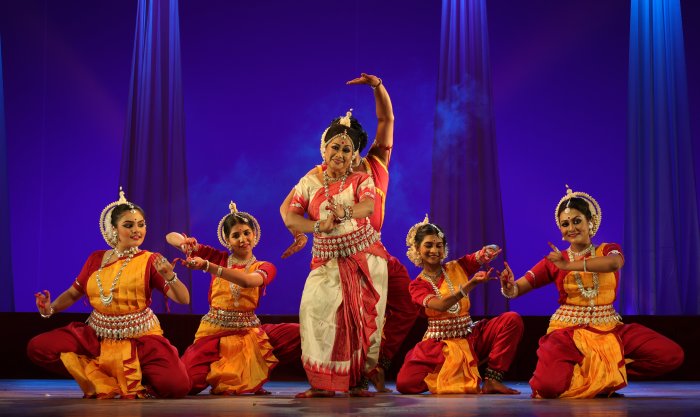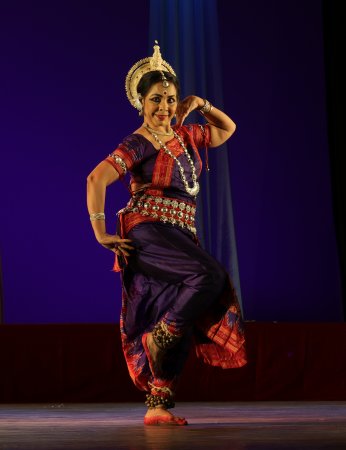
|   |

|   |
Nrityangana celebrates 30th anniversary - Tapati Chowdhurie e-mail: tapatichow@yahoo.co.in Photos courtesy: Maya Bhattacharya June 11, 2025 Girish Mancha in Bagbazar, Kolkata, named after the great theatre personality Girish Ghosh, was inaugurated by the then Chief Minister of West Bengal, Jyoti Basu, on 1st July 1986. Bagbazar on the banks of the river Ganga is well known by the followers of Ramakrishna Paramhansa, because Sarada Devi, his consort, spent her twilight years in Bagbazar. During auspicious days, Ganga Arati is held here.  Maya & Nrityangana group In this punyabhumi (sacred place) of Bagbazar, Nrityangana presented a special evening of Odissi recital at Girish Mancha on June 4. Maya Bhattacharya, the artistic director, and her entire team celebrated their 30th anniversary with a bunch of her work. A disciple of Poushali Mukherjee, and hence the Kelucharan Mohapatra style of Odissi, Maya Bhattacharya has been a practitioner of the genre in her own humble way for more than three decades. Off and on, she has attended workshops and training in Odissi under the legend of Odissi, which has given her a vision and helped in nurturing her passion for Odissi. In the absence of Guru Kelucharan Mohapatra, Maya Bhattacharya regularly trains with Guru Ratikant Mohapatra to fuel her passion for Odissi. Starting with the song in praise of Hari, glorifying his supreme personality, who is bedecked and bejewelled with earrings and a garland of forest flowers and whose feet are marked with a lotus - "Srita kamala kucha mandala kalita lalita vana mala jaya jaya deva hare" of Kavi Jayadeva's Gita Govinda - Maya sailed through the evening presenting a bouquet of her own short compositions. Nritya Sangam and Dasavatar, choreographed by Maya Bhattachaeya, was the combination of nritya, geeta, and vadya, with each complementing the other to produce Sangeeta, which in fact is the essence of dance, because dance doesn't exist in isolation; music, both vocal and instrumental, are its integral part. Bharatiya Sangeet Sastra mentions four kinds of musical instruments - Tat Vadya, Sushir Vadya, Avanaddha Vadya and Ghana Vadya - which should accompany musical soirees and dance recitals. All four types of musical instruments, as well as vocal singing, created a rich melody to accompany the dance. Music was composed by Debasish Sarkar. Beautiful strains of raga Kirwani created an aesthetic atmosphere. It was in the rhythm cycle of Atatali. Aratrika in praise of Goddess Kali in Puriya Dhanasree and Chautal of the 12 matra beat was a devotional piece followed soon after by the "Abhisaar Chali Sur Taal" song by Maya and her group, dealing with the romance and trust between melody and rhythm. It was a good concept. The last piece composed and choreographed by Bhattacharya was "Mai Varsha hoon" scripted by Punya Darshan Gupta, personifying Varsha. What strikes me most about dancers and dance choreographers like Maya Bhattacharya is that their world revolves around finding joy in Sangeeta, amidst all the chaos that exists in today's world. There are umpteen numbers of dance schools in the length and breadth of Kolkata, which has no dearth of students. Performance space is provided by the Artistic Directors of these schools. Auditoriums go full house, accommodating doting parents and relatives. This flow of Ananda, like an ever-flowing stream, is a panacea that seemingly offers a cure to all that ails the modern world.  Kakoli Bose Young students of Maya Bhattacharya enjoyed dancing and she had provided performance space to Odissi dancers Kakoli Bose and Saswati Sarkar. Kakoli Bose and her daughter Arkapala performed Desh Pallavi, while Saswati Sarkar's Sringar Pallavi was a group rendition. Arkapala Bose has potential if she nurtures it meticulously. The Odissi performances of all the dancers adhered to their roots. However, the same cannot be said about the Bharatanatyam duo Arijit and Sulagna Banik. Their music was a rendition of Iman Chakraborty's YouTube version. Live music for a performance is not cost-effective is known. Dancers can at least have appropriate recorded music, if they aspire to be dancers. In their performance, the romance between the eternal lovers of Indian mythology was basely dealt with. Their dance was more like a blockbuster film's dance, which has a large following.  Tapati Chowdhurie trained under Guru Gopinath in Madras and was briefly with International Centre for Kathakali in New Delhi. Presently, she is a freelance writer on the performing arts. She is the author of 'Guru Gopinath: The Making of a Legend.' |